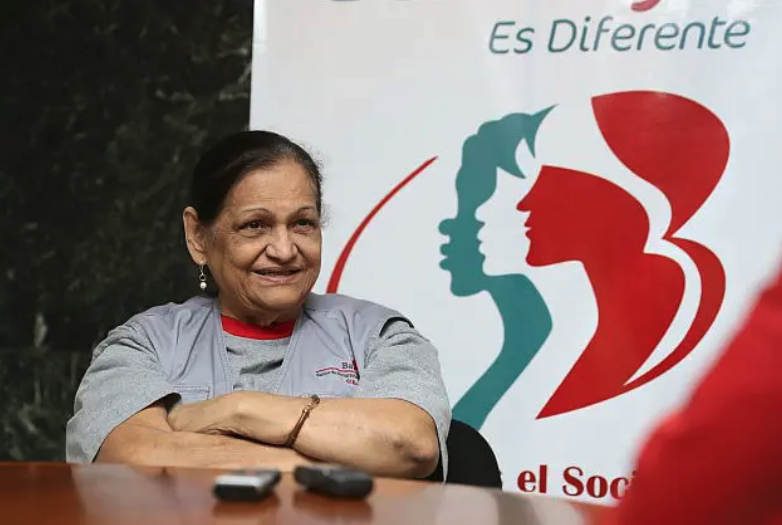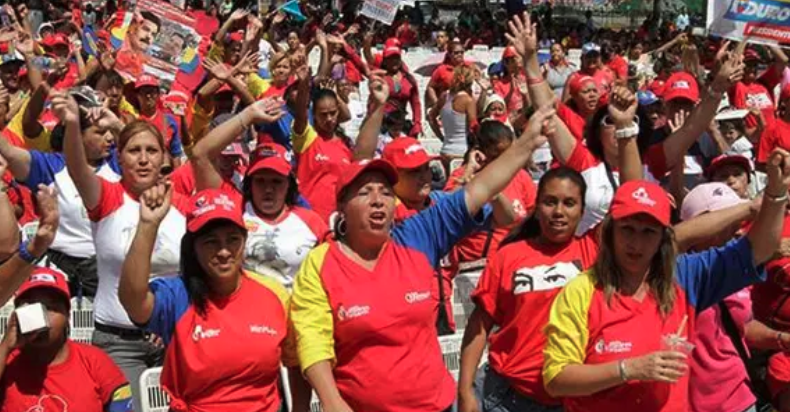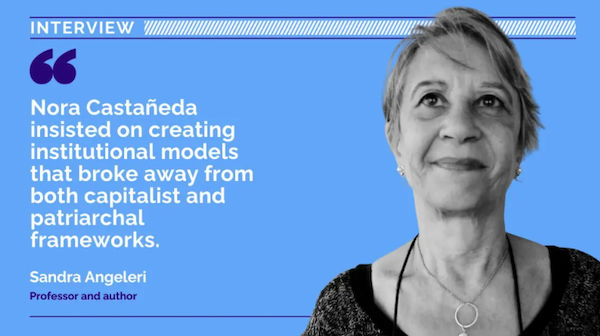Historian Sandra Angeleri has just published a new book that tells the story of Nora Castañeda (1942-2015), a feminist economist who played an important role in the Bolivarian Revolution under Chávez’s governments. Based on interviews Angeleri did with Castañeda in her final years, the book follows the revolutionary economist from her working-class upbringing in Caracas and participation in clandestine struggles to her later realization that women needed a material, economic, and financial basis for their emancipation. These reflections led Castañeda to found the Banco de Desarrollo de la Mujer (Women’s Development Bank), also known as Banmujer, one of the most innovative institutions to emerge in the early years of the Venezuelan revolution. Angeleri’s book is titled ¿Una banca revolucionaria? La historia de Nora Castañeda y su liderazgo en el Banco de Desarrollo de la Mujer de Venezuela (El Perro y la Rana).
Cira Pascual Marquina: I remember Nora Casteñada from her participation in numerous panel discussions in the first decade of the Bolivarian Revolution. She also made frequent television appearances. Could you sketch her life trajectory?
Sandra Angeleri: Nora Castañeda was born in Caracas in 1942. She was an economist and a feminist who grew up in the barrios of Cotiza and 23 de Enero in Caracas. Her life in these working-class communities shaped her in a profound way, and she became involved in the struggle against the Marcos Pérez Jiménez dictatorship [1952-58] while still in high school.
At that time, she came into contact with Venezuela’s Communist Party and with the radical wing of Acción Democrática, which would later become the Revolutionary Left Movement [MIR]. Nora was drawn to revolutionary politics from below and advocated for the radical transformation of social relations. At that time, Venezuela was a country that had transitioned from being mainly rural to mainly urban due to the oil boom, but vast social sectors—especially in the barrios and rural areas—remained excluded.
Nora’s commitment to feminism was grounded in her early life. Her mother, a single woman who migrated to Caracas from Lara state, was a barrio activist. That’s how she came to understand that working-class communities are generally organized by women. All this led Nora to develop a political identity rooted in the working-class experience and shaped by the daily struggles of women.

Nora Castañeda (Banmujer)
CPM: How did she relate to Marxist and feminist theory?
SA: Throughout most of her life, Nora worked to bridge Marxism and feminism. In the 1980s, there were intense debates within the women’s movement. Long before that, however, she had already challenged the marginalization of women’s issues within leftist parties, where women were often treated as just another “sector”—like youth—and they were told they would have to wait until after the socialist revolution to overcome patriarchal oppression.
Nora advocated for a socialist feminism rooted not in the opposition between women and men, but in the collective transformation of social relations. I remember her remarking that when Chávez embraced feminism, many women saw it as an opportunity and said, “Now that he’s called himself a feminist, let’s make sure that translates into concrete advances!”
As a young woman, Nora studied economics—particularly Marxist economics—and that intellectual formation always remained with her. Yet she was, above all, a woman who was part of the struggle. One of the defining features of her life was the integration of theory and practice: for Nora, economic thought had to translate into tangible transformation. That’s why working alongside working-class women wasn’t just a political commitment; it was part of her daily practice.
CPM: How did Dependency Theory, which employs “superexplotation” as a category, inform Nora’s feminist thinking?
Nora was strongly influenced by 1970s Dependency Theory, which analyzed the extraction of value from the capitalist periphery to the center. She used that framework to understand the unpaid reproductive labor of women in society.
Drawing on Marxist-feminist thinkers—some from Europe, others from Latin America—she argued that the unpaid labor of women underpinned the whole economy. In her view, women’s domestic labor was simultaneously invisible and central to the capitalist system; so it was akin to superexploitation.
She promoted consciousness-raising workshops to explore these issues and engaged with Italian feminists like Ornella Pellegrini, who criticized the subordinate role of women in communist parties. While the contradictions were many, she knew that it was necessary to continue working within Left organizations: it was—and continues to be—urgent to overcome both patriarchy and capitalism.
CPM: How did these theoretical commitments shape Casteñeda’s later political activity during the Bolivarian Process?
SA: The women’s movement made important advances in the 1980s and 1990s, among them a campaign to include unpaid domestic work in GDP calculations. These early steps laid the foundation for more transformative changes in the years to come.
During the 1999 Constituent Assembly process, Nora and many other women fought to secure inclusive language and the recognition of unpaid domestic labor in the new constitution. It was an uphill battle. Only 17% of the elected delegates were women, and feminist proposals were often blocked or watered down along the way. In response, activists maintained a daily presence in committee sessions, organized picket lines, and even brought in Italian linguist Vicky Ferrara to help ensure that inclusive language wasn’t quietly removed during late-night sessions.
Eventually, Article 88 of the Constitution was passed, recognizing the economic value of unpaid care work and establishing the right to social security for those who perform it. This was a historic victory, but Nora understood that legal recognition alone was not enough. For her, real transformation had to begin with the economy itself.
In any case, Article 88 is the foundation for the current right of all women in Venezuela to receive a pension, including those who have not contributed to social security.
CPM: In 2001, after only two years of the Bolivarian Revolution, Nora became president of the newly-founded Women’s Development Bank, better known as Banmujer. How did the idea of this bank come to exist?
SA: The idea for Banmujer had been floating around since the Fourth World Conference on Women in Beijing in 1995, but it gained traction with the rise of the Bolivarian Process. After Beijing, President Rafael Caldera entertained the proposal, but he had no real interest. Chávez, on the other hand, embraced it fully.
The bank was envisioned as much more than a financial institution. Banmujer was to be a tool to challenge and transform both patriarchal and capitalist structures. It was designed to avoid “assistencialismo” [non-transformative social assistance] by providing financial support to groups of organized women, not to individuals. Equally important was the bank’s commitment to technical assistance and education, as well as political empowerment.
When Chávez appointed Nora to the task, she and her team spent six months planning the bank before the official launch. Banmujer wasn’t going to be a generic financial institution, so designing a good institutional architecture was extremely important. Banmujer broke with the logic of traditional banking: instead of waiting for women to come to the bank, the bank went to the women—in the barrios and rural communities.
Banmujer offered low-interest microcredits and always accompanied its financial support with educational workshops. These ranged from workshops on self-esteem to others that focused on health and raising awareness about gender-based violence. These educational spaces were always framed in terms of collective empowerment and political education.
CPM: So Banmujer was both a financial tool and a movement for transformation?
SA: Exactly! Castañeda saw the bank as a space for economic transformation tied to the creation of new social relations. It wasn’t just about lending money; it was about forming a nationwide network of women with economic autonomy and generating a new political subjectivity, while pushing forward the Bolivarian Revolution from the bottom up.
At one point, the bank had around 40,000 women participating. It built a network of promoters in every state and community—women who were trained not just to manage credit portfolios but to organize people and transform things. Banmujer overcame the constraints of the financial system by focusing on sectors of society that capitalism ignored: small-scale food production, garment making, and women’s agriculture.
CPM: Nora Castañeda died in 2015. What became of Banmujer after her death?
SA: Nora died at a difficult time for the Bolivarian Process, when there was an escalation of U.S. attacks and an economic crisis. In fact, shortly before she passed, the bank was subject to government intervention.
Nora had always been a disciplined cadre and facilitated the intervention, but Banmujer quickly lost its vitality when she passed. When I interviewed Janet Vicuña, the bank’s new director, in 2019, she said there were practically no funds left for loans, and the institution had become inactive. The bank—or rather its beautiful project—was another victim of the crisis brought upon this country.

A feminist march in 2016. (Alba Ciudad)
CPM: What is Nora Castañeda’s most important legacy for our time?
SA: Her legacy rests on two main pillars. First, there was her commitment to fostering political awareness and agency among working-class women—an idea that still inspires and shapes struggles in Venezuela today. Second, there was her insistence on creating institutional models that broke away from both capitalist and patriarchal frameworks. She challenged the notion that you can just invert capitalist logic and call it revolutionary.
Banmujer was a tool for transformation, but Nora always warned that if this transformation served merely to reform the patriarchal state, it would fall short of the objective. She believed the goal was not to be absorbed into the state, but to transform it. That remains an issue we must wrestle with today in the Bolivarian Revolution.

